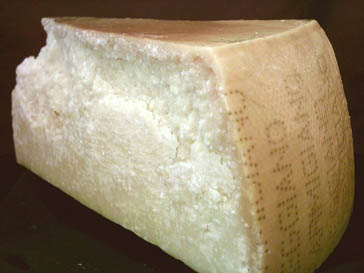The Parmigiano Reggiano or Parmesan cheese as it is called in English is considered to be among the top cheeses by cheese connoisseurs
Parmigiano-Reggiano is a hard, granular cheese, cooked but not pressed, named after the producing areas near Parma, Reggio Emilia, Modena, and Bologna (all in Emilia-Romagna), and Mantova (in Lombardia), Italy. Under Italian law, only cheese produced in these provinces may be labelled "Parmigiano-Reggiano", and European law classifies the name, as well as the translation "Parmesan", as a protected designation of origin.

Parmigiano Reggiano
Parmigiano is the Italian adjective for Parma. Reggiano is the Italian adjective for Reggio Emilia. In the US the name Parmesan is used for cheeses which imitate Parmigiano-Reggiano, along with phrases such as "Italian hard cheese".
Production
Parmigiano-Reggiano is made from raw cow's milk. The whole milk of the morning milking is mixed with the naturally skimmed milk (which is made by holding milk in large shallow tanks to allow the cream to separate) of the previous evening's milking, resulting in a part skim mixture. The milk is pumped into copper-lined vats (copper heats and cools quickly). Starter whey is added, and the temperature is raised to 33–35 °C (91–95 °F). Calf rennet is added, and the mixture is left to curdle for 10–12 minutes. The curd is then broken up mechanically into small pieces (around the size of rice grains). The temperature is then raised to 55 °C (131 °F) with careful control by the cheese-maker. The curd is left to settle for 45–60 minutes. The compacted curd is collected in a piece of muslin before being divided in two and placed in molds. There is 1100 L (291 US gallons or 250 imperial gallons) of milk per vat, producing two cheeses each. The curd making up each wheel at this point weighs around 45 kg (100 lb). The remaining whey in the vat was traditionally used to feed the pigs from which "Prosciutto di Parma" (cured Parma ham) was produced. The barns for these animals were usually just a few yards away from the cheese production rooms.
 The sign on the border of the provinces of Parma and Piacenza, indicating the start of the area of origin
The sign on the border of the provinces of Parma and Piacenza, indicating the start of the area of origin
The cheese is put into a stainless steel, round form that is pulled tight with a spring-powered buckle so the cheese retains its wheel shape.


